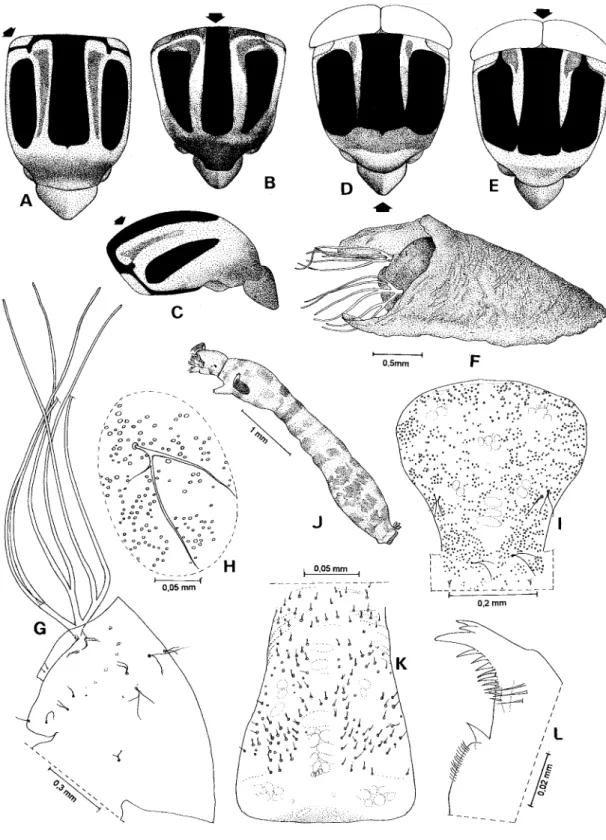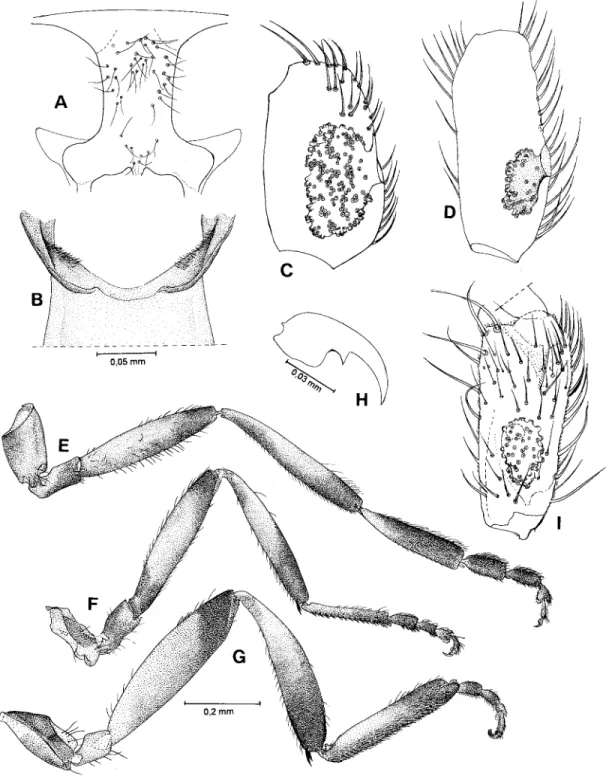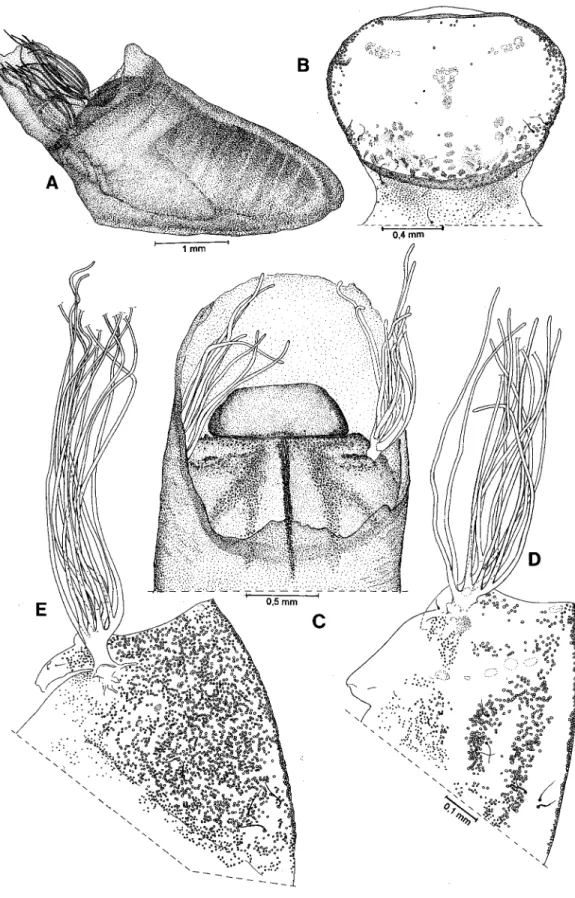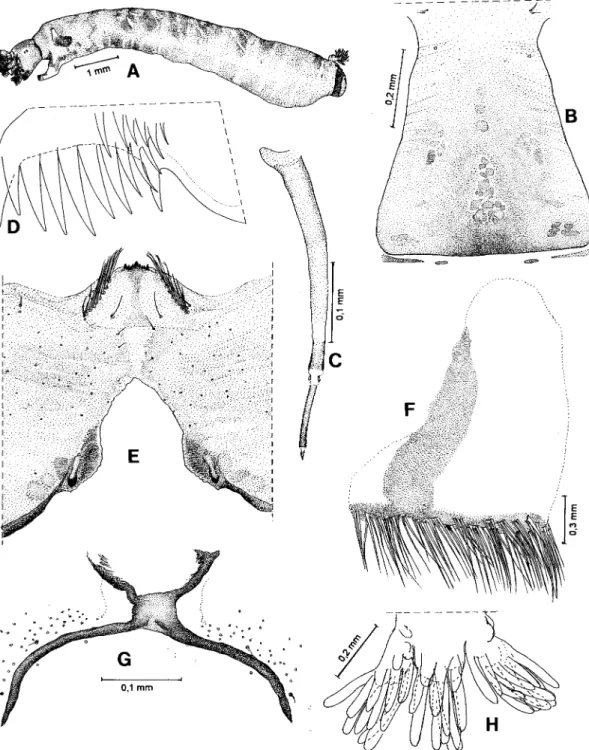179 179 179 179 179 Mem Inst Oswaldo Cruz, Rio de Janeiro, Vol. 95(2): 179-187, Mar./Apr. 2000
New Species Records for the Blackfly (Diptera-Simuliidae)
Fauna of Argentina with Description of Adults, Pupa and
Larva of
Simulium oyapockense
s. l. and
S. seriatum
S Coscarón/* /
+, CL Coscarón-Arias
Facultad de Ciencias Naturales y Museo, 1900 La Plata, Argentina *Facultad de Ciencias Agrarias, 8303, Cinco Saltos, Río Negro, Argentina
Two blackfly species Simulium (Cerqueirellum) oyapockense Floch & Abonnenc and S.(Hemicnetha) seriatum Knab are recorded from Argentina, representing the most southern register for both species. S. oyapockense is a species epidemiologically very important, as a vector of onchocerciasis in the Amazo-nian focus. Both species are described and illustrated and their distribution are reported, in similarity to others like S.roraimense Nunes de Mello and S. ganalesense Vargas et al. in reference to S.oyapockense
and S. mexicanum Bellardi similar to S. seriatum are discussed.
Key words: Argentina blackflies - new records - Simulium oyapockense - Simulium seriatum -morphological description
In Argentina 68 blackfly species are recorded, occurring from the north of the country to Tierra del Fuego. Among them at least eight species are very well known because they are biting pests of man and some are vectors or potential vectors of human onchocerciasis as Simulium exiguum, S. incrustatum and S. minusculum. Two species are recorded as new to Argentina in this paper: S. (Cerqueirellum) oyapockense Floch & Abonnenc and S. (Hemicnetha) seriatum Knab. The first spe-cies is epidemiologically very important, as an On-chocerca volvulus vector in the Amazonian on-chocerciasis focus (Shelley 1988, Py-Daniel 1997, Shelley et al. 1997).
S. oyapockense is a species with a large distri-bution, known from Guyana, Venezuela, Panama, Colombia, Ecuador and Brazil. It lives in a variety of environments and consequently has been de-scribed under several different names. Today it is considered as a species complex (Shelley et al.
1997). As there are extensive descriptions (Py-Daniel 1983, and especially Shelley et al. 1997) we will give only a diagnosis based on the Argen-tina specimens, in order to show the differences with the closest species. Also S. (Hemicnetha) seriatum Knab is another species with a distribu-tion on the western border of the Neotropical re-gion being found in Venezuela, Colombia, Ecua-dor, Peru and Bolivia (Coscarón 1987, Crosskey
& Howard 1997). Here we add records of material from NW Argentina in the Yungas area.
MATERIALS AND METHODS
The material was collected by the authors, from aquatic plants and submerged leaves and branches of trees and bushes and stones. Pupae were main-tained individually in humid vials until emergence and then mounted or preserved in 80% ethanol. Larvae of S. oyapockense were either fixed in Carnoy for cytological studies or in ethanol for morphological studies. Studies were made by ste-reoscopic microscope; some material of different stages was dissected and mounted on slides for observation using the compound microscope. For the supraspecific denomination of taxa we use the system employed by Coscarón (1987). Specimens were deposited in the La Plata Museum (MLP), Argentina.
RESULTS
Simulium (Cerqueirellum) oyapockense
Floch & Abonnenc 1946: 4
The synonyms cited are S. pseudosanguineum
Ramírez Pérez & Peterson, 1981: 154; S. sanchezi
Ramírez Pérez, Yarzabal & Peterson, 1982: 71; S. cuasisanguineum Ramírez Pérez, Yarzabal & Peterson, 1982: 36 and more recently S. pseudoamazonicum Ramírez Pérez & Peterson 1981: 151, (synonymyzed by Shelley et al. 1997: 19). Several cytoforms and morphoforms are men-tioned by Crosskey and Howard (1997).
DIAGNOSIS
Female: wing length 1.6-2.1 mm (n = 6, x = 1.7 mm). General coloration blackish, with silver +Corresponding author. Fax: 0221-4257527. E-mail:
180 180 180 180
180 Records for Blackfly Fauna S Coscarón, CL Coscarón-Arias
pruinosity. Frons silver iridescent, clypeus silver pruinose. Scutum with three black vittae bordered by silver pruinosity, the submedian silver stripes showing an elongated comma-shaped mark with an antero-lateral illumination (Fig. 1A), or observed laterally with antero-superior light position (Fig. 1C); with front superior illumination black median vittae narrower and more elongated posteriorly, submedian black vittae elongated anteriorly and comma-shaped marks shorter (Fig. 1B); with pos-terior illumination black vittae slightly shorter and silver area increased with submedian bands reach-ing anterior scutal margin and lackreach-ing anterior comma-shaped marks. Scutum pilosity golden, metanotum and scutellum black. Abdomen dark brown to black with 1+1 silver spot on T II; T III-V velvet black with narrow latero posterior area silver pruinose, T VI-VIII shiny and waxy. Frons with subparallel sides slowly convergent ventrally, frontocular triangle absent, basal portion of cibarium with 23-27 acuminate teeth on each side, extending from borders of deep central area to the cornua; sensorial organ of palp a half or nearly 1/3 length of basal article of palp, claws without sub-basal teeth; paraproct short with rounded border, VIII sternite with 14-18 hairs and gonapophysis slowly divergent below with sclerotized borders.
Male: wing length 1.7-1.8 mm (n = 2). Coloration similar to female. Scutum with 1+1 black, subme-dian, silvery cunae extending for more than half of scutum length, but generally not joining with silvery posterior area (Fig. 1 D-E); length of cunae change with the light position. Genitalia in accor-dance with the morphology of this subgenus. Basistyle subquadrate about as long as high, dististyle subtriangular with strong club-shaped spine; ventral plate with short basal arms and rounded border.
Pupa: cocoon length (n = 12) on dorsum 2.1-2.6 mm (x = 2.3 mm) on base 2.5-3.2 mm (x = 2.7 mm), light yellowish brown coloration. Cocoon slipper shaped, sligtly protruding dorsally and ba-sally, and covering the gill base (Fig. 1F). Cocoon made of soft and thick tissue with closely woven threads obscuring the pupa; gill length 1.2-1.4 mm (n = 5), (x = 1.3 mm). Frontoclypeus with moder-ately abundant rounded platelets; facial trichomes bifid with 1+1 or 2+2 single frontal trichomes (Fig. 1I). Respiratory gill with six filamentous branches subdivided near the base, showing a short basal trunk and three short primary branches (Fig. 1G). Disc of thorax with numerous rounded platelets, but with some pointed on posterior area and 5+5 bifid trichomes mainly bifid (Fig. 1H).
Larva: length (last instar) = 4.1-4.7 mm (n = 5) (x = 4.3 mm). Color (in alcohol) yellowish white with greenish spots (Fig. 1J) and a circular band around
anterior third of abdomen; head yellowish gray; cephalic apotome scarcely light brownish at base, with pale median longitudinal stripe and 1+1 sub-median spots, covered by abundant long and single to bifid trichomes leaving free only the pigmented area (Fig. 1K). Deep sub-circular gular cleft. Ra-tio hypostomium/hypostomial bridge = 2-2.7; hypostomium teeth at same level, with 4+4 to 5+5 lateral chaetae and 7-8 lateral serrations on each side. Antenna thin, with ratio of articles I-III being 1:0.9-1.1:1-1.2. Mandible with 5-6 internal teeth, 2 marginal teeth, (the second small and isolated from the anterior), fringe of supramarginal chaetae and presence of 2-3 mandible lateral process (Fig. 1L). Cephalic fan with 27-38 principal rays. Pro-leg comb with about 40 teeth in 7-8 groups. Body integument with abundant palmate trichomes 0.02 mm in length. Anal sclerite with few hairs. Anal ring with 57-63 rows with 12-15 hooks on each. Anal gill with 3 lobes each with 2-3 lobules.
Material examined: Argentina: (material collected by the first author and deposited in MLP collec-tions) Tucumán Province, Lamadrid, river Marapa, on route 301, 21-VI-95: 1 female, 2 males, 13 pu-pae, 16 larvae; idem 16-IX-96, 12 reared females and 4 reared males, several pupae, 1 larva. Santiago del Estero Province, river Dulce over Santiago del Estero city, 19-VI-95: 13 pupae, 1 larva. Salta Prov-ince, Aguas Blancas, road to Yaculika farm col-lected on man and inside vehicle, 28-I-98: 11 fe-males; river San Francisco on route 5, 28-VII-97: 3 pupae, 2 larvae; river del Valle on route 41, 30-I-98: 1 pupa, 5 larvae. Brazil: State of Amazonas, river Uatuma, 11-VIII-83, coll. U Barbosa, det. Py-Daniel: 1 reared male, 1 reared female and larvae.
Discussion: our material is in accordance with the descriptions of S.oyapockense of Py-Daniel (1983) and Shelley et al. (1997). Generally some of our specimens are a little longer than that recorded by those authors. One of the differences is the pres-ence in the male of silver stripes on the scutum of different length, and in some specimens joining with the posterior silver area, indicating that this character used to differentiate roraimense is unre-liable. Platelets on free portion of thorax of pupa are always rounded distally in Argentina material, but those more posteriorly positioned pointed apically, not so prominent as figured for S.
ap-181 181181 181181 Mem Inst Oswaldo Cruz, Rio de Janeiro, Vol. 95(2), Mar./Apr. 2000
182 182 182 182
182 Records for Blackfly Fauna S Coscarón, CL Coscarón-Arias
proximately at the same distance from the base, the terminal gill branches are proportionately longer, platelets are absent on the frontoclypeus as also on the area of the thorax disc which is smooth, and the presence of 2-4 branches in the thoracic trichomes. These characters help to separate the pupae of both species. Other important characters for separating both species are the absence of a fringe of supramarginal chaetae on the mandible border in the larva of S. minusculum and the sub-terminal dististyle spine is more central positioned and the anterior silver cunae on the scutum of S. minusculum are shorter.
S.chaquense with 8 and S.cuneatum with 10 gill branches in the pupa permit them to be easely distinguished from S. oyapockense. Simulium delponteianum has 6 gill branches, but is much larger and more grayish in color and the presence of several spines in the male dististyle, separates this species from S. chaquense, cuneatum, oyapockense, minusculum
Another species, S. ganalesense Vargas, Martinez Palacios and Díaz Nájera from Mexico, occurring in the northern limits of the Neotropical region is very similar (Coscarón & Ibañez Bernal 1994). Female ornamentation, gill branch distri-bution and platelets of pupae are similar; small dif-ferences are found in the male scutum where sil-very longitudinal stripes join with the silver prui-nose posterior band as is in S. roraimense (and one specimen of S. oyapockense from river Marapa), and the female shows less sclerotization of the den-tate border of the cibarium. This is further evidence for the close phylogenetic relationship among dis-tant populations of this species complex; possibly new evidence will be obtained from material from intermediate areas, or using other non morphologic characters to clarify the taxonomic status of
oyapockense – roraimense – ganalesense.
Simulium (Hemicnetha) seriatum Knab
Simulium seriatum Knab, 1914: 81
Trichodagmia laticalx Enderlein, 1934: 291
Trichodagmia latidigitus Enderlein, 1936: 129
DIAGNOSIS
Female: wing length 3-3.3 mm (n = 4). General coloration dark brownish. Head dark brown, frons and clypeus brownish with grayish pollinosity; antennae and legs dark brown; scape and pedicel yellowish brown. Scutum reddish brown to black-ish, pollinose with grouped hairs showing gray to golden iridescent scales depending on illumination. Scutellum and metanotum dark brown; pleura dark grayish brown, pollinose. Legs blackish on tarsites and brown on femora and tibiae (Fig. 2 F-G). Ab-domen blackish with T II with 1+1 submedian
sil-very spots and posterior border dark brown; T VI-IX shiny and waxy. Frons convergent below, deep frontocular triangle (Fig. 2A). Smooth cibarium base, emarginated basally and laterally near the cornua with small spicules and more sclerotized (Fig. 2B). Mandibles with 35+13, maxillae with 12+13 teeth. Sensorial maxillary palp organ mostly enlarged (Fig. 2C), rarely small (Fig. 2D). Scutum with grouped hairs intercalated. Basal sector of R with hairs. Ratio length/width of posterior basitarsus = 5.6; claw with strong sub-basal teeth (Fig. 2H). Genitalia: paraproct robust, subrectan-gular with abundant microtrichiae, cercus rounded on external border (Fig. 3A); VIII sternite with a medium transversal sclerotized spot, gonapophysis about as long as wide, subovoidal with rounded apical border (Fig. 3B). Genital fork with robust branches and distal apodemes (Fig. 3C).
Male: wing length 2.7-2.9 mm (n = 3). Coloration similar to female but more dark; scutum blackish brown, pollinose, without special ornamentation. Abdomen brown with 1+1 silvery, pollinose, sub-lateral spots on T II, IV-VII. Basal sector of R with-out hairs. Ratio length/width of posterior basitarsus = 3.1-3.8. Basistyle subtrapezoidal, dististyle about two times the basistyle length, with soft rounded lateral projection and thin apical spur (Fig. 3D); endoparameres with strong hooks (Fig. 3E); basal plate, wider than high with median keel and abun-dant spines (Fig. 3F).
Pupa: cocoon shoe-shaped, projecting anteriorly with anterior border reinforced; thick tissue with-out visible threads (Fig. 4A). Length (n = 8) ba-sally 3.5-3.9 mm (maximum 5 mm), on dorsum 2.6-3.4 mm, gill branches length 1.5-1.6 mm. Frontoclypeus with few platelets mostly on base border and laterally reinforced basally with some wrinkles (Fig. 4B); trichomes single with 1+1 fa-cial and 2+2 frontal. Exposed thorax area, with external border granulose with big sub-globose platelets arranged in three longitudinal bands: one median narrow with platelets more darkened and two sub-lateral, the external diagonally placed and joined anteriorly with the sub-basal band (Fig. 4 C-D). Respiratory gills with 12 filamentous branches, emerging from 3 short primary branches that originate from short basal trunk (Fig. 4D).
ar-183 183183 183183 Mem Inst Oswaldo Cruz, Rio de Janeiro, Vol. 95(2), Mar./Apr. 2000
Fig. 2: Simulium (Hemicnetha) seriatum. A-H: female. A: frons; B: basal portion of cibarium; C-D: sensorial organ of maxillary palp (both from Marapa river); E-G: first, second and third pair of legs; H: claw. S. (Hem.) mexicanum. I: sensorial organ of maxillary palp (from Kikuya river, Acatenango, Guatemala).
ranged in two rows, only one marginal tooth elon-gated and pointed distally (Fig. 5D). Maxillary palp with 4-5 sensorial organs on apex. Hypostomium with short teeth, the angle teeth as high or lower than the median tooth, lateral setae in number of
184 184 184 184
184 Records for Blackfly Fauna S Coscarón, CL Coscarón-Arias
Fig. 3: Simulium (Hemicnetha) seriatum. A-C: female. A: paraproct and cercus; B: eighth sternite and gonapophysis; C: genital fork; D-F: male. D: basistyle and dististyle; E: endoparameres and median sclerite; F: ventral plate. (Figs. A, C, D similar scale). each; anal sclerite as Fig. 5G. Anal gill with three
lobes each with 9-14 lobules (Fig. 5H).
Material examined: Argentina: Jujuy Province, Caimancito river, on 34 road, 12-III-92, coll. Coscarón: pupae, (MLP); Capilla river, 20 km E of Normenta, 25-VIII-97, coll. Coscarón: pharates fe-male and fe-male, pupae, larvae (mounted in slides)
27/31-185 185185 185185 Mem Inst Oswaldo Cruz, Rio de Janeiro, Vol. 95(2), Mar./Apr. 2000
186 186 186 186
186 Records for Blackfly Fauna S Coscarón, CL Coscarón-Arias
Fig. 5: Simulium (Hemicnetha) seriatum. A-H: larva. A: general aspect; B: cephalic apotome; C: antenna; D: mandible; E: hypostomium and gular cleft; F: proleg sclerite; G: anal sclerite; H: anal gills. (Figs B, E similar scale).
VIII-62, 740 m, coll. Peña: 2 females (MLP). Ecua-dor: Pichincha State, on road to Santo Domingo lake, 7-VIII-69, coll. P. & B. Wygodzinsky: pharate fe-male and pupae, (AMNH); Chimborazo State, Multitud, Citado river, 1030 m, 7-XI-86, coll. Coscarón: reared male, pupae and larvae, (MLP); Cañar State, Sacramento, 550 m, 3-XI-86, coll.
24-187 187187 187187 Mem Inst Oswaldo Cruz, Rio de Janeiro, Vol. 95(2), Mar./Apr. 2000
VII-70, coll. Howden: 1 female (AMNH); Venezu-ela: Yaracuy State, Dto. Bolivar, Beroes, Minas Aroa, Tupe river, 450 m, 1 reared female; Táchira State, Dto. San Cristobal, El Carozo, 1 reared male, both determinated by Ramírez Pérez as S. mexicanum.
Distribution: Argentina: Jujuy; Bolivia: Beni; Peru: Lima and Cuzco; Ecuador: Pichincha, Chimborazo, Cañar; Colombia: Valle and Venezuela: Distrito Federal, Yaracuy, Táchira.
Discussion: our material is in accordance with the type and author’s description. Also adults are simi-lar to S. mexicanum Bellardi, but show small dif-ferences in the preimaginal stage morphology.
In the pupa the thoracic platelets in S.
mexicanum are very abundant and cover homoge-neously the exposed area (Fig. 4F), the platelets are strongly sclerotized and more spiculate distally, also the frontoclypeus platelets are abundant. In S.
seriatum the thoracic platelets are more scarce and leave smooth areas (Fig. 4 C-D); in dorsal view it is possible to see three stripes; the frontoclypeus is practically smooth.
Another difference is the sensorial organ of the maxillary palp which in S. mexicanum is propor-tionally smaller with ratio = 2.9-3.3, (x = 3.1 mm, n = 6) (Fig. 2 E), and in S. seriatum is = 1.6-2.9, (x = 2.1 mm, n = 10). Also in S. mexicanum the co-coon is thicker, thereby obscuring the pupa and is more reinforced on the anterior border.
ACKNOWLEDGEMENTS
To Nélida R Caligaris for the illustrations.
REFERENCES
Coscarón S 1987. El Género Simulium Latreille en la Región Neotropical: Análisis de los Grupos Supraespecíficos, Especies que los Integran y Distribución Geográfica (Simuliidae, Diptera), Museo Paraense Emilio Goeldi, Coleção Emilie Snethlage, Belém, 111 pp.
Coscarón S, Ibañez-Bernal S 1994. Sobre la ubicación taxonomica de Simulium ganalesense Vargas, Martínez Palacios y Díaz Nájera (Diptera-Simuliidae). Folia Entomol Mex 90: 1-7.
Crosskey RW, Howard TM 1997. A New Taxonomic and Geographical Inventory of World Blackflies (Diptera: Simuliidae), Dept. of Entomology, The Nat. Hist. Mus., London, 144 pp.
Py-Daniel V 1983. Caracterização de dois novos subgeneros em Simuliidae “Diptera. Culicomorpha”. Amazoniana 8: 159-223.
Py-Daniel V 1997. Oncocercose, uma endemia focal no hemisfério norte da Amazônia. In Barbosa, Gondim & Castellon (eds), Homem, Ambiente e Ecologia no Estado de Roraima, INPA, Manaus, p. 111-155. Shelley AJ 1988. Vector aspects of the epidemiology of
onchocerciasis in Latin America. Ann Rev Entomol 30: 337-366.




